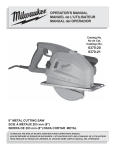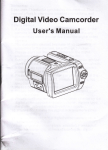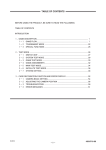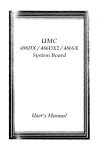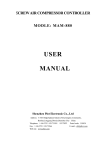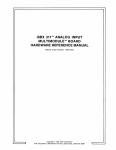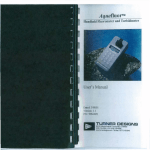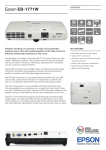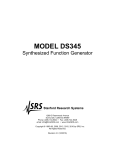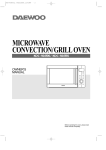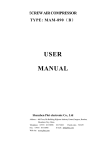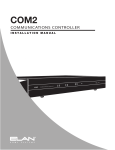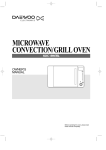Download VESA LOCAL BUS
Transcript
VESA LOCAL BUS 3486 VL-BUS 3486 786 MINI-BOARD USER’S MANUAL Introduction ....................................................................2 Chapter 1 Main Features of System Board.. ....................3 Intel 486SX, 486DXf2,486DX, 386DX Microprocessor ..................................................3 64 MB On-Board Main Memory.. ......................3 Secondary Cache Memory System .....................3 USA Integration Chip Set ..................................4 8 Fully Accessible Bus Slots ..............................7 Component Layout ................................8 Chapter 2 Hardware Configuration .................................9 Static Discharge Precautions 1. ............................9 Jumper Settings ..................................................9 Cache Memory Size Jumper .................. 10 486 DX/ SX Selection Jumper.. .............12 Numeric Processor Jumper ....................12 CPU Type Jumper .................................13 486-50 MHz CPU Jumper .....................13 CPU Clock Frequency Jumper.. .............14 VESA Local Bus Jumper .......................15 Battery Setting Jumper .......................... 15 Processor Installation .........................................16 Installing CPU .......................................16 Memory Installation........................................... 17 Available SIMM Configurations........... .17 InstaIling SIMMs ...................................19 Automatic Memory Sizing .....................19 Available Cache SRAM Configuration.. 20 Installing Cache SRAM .........................21 Chapter 3 Installation Guide ...........................................24 Static Discharge Precautions .1 ............................24 Installing The System Board ..............................24 Installing Power Connector ................................25 Connecting the Keylock, Reset & Turbo Switches 26I Chapter 4 Using the BIOS Setup ................................... 21 1 The 786 AI0 system board is a “MINI” AT size, fully PC/AT compatible motherboard with two 32 bit VESA standard Local Bus slots, and the ability to use 486 or 386 microprocessor. It combines the latest technology with design elegance unsurpassed by other comparable system boards. With a sophisticated secondary cache of 64 KB , 128 KB, or 256 KB high speed SRAM, and a maximum of 64 MB on-board main memory, it is well suited for all high-end applications such as fileservers and advanced workstations. The 786 AI0 system board incorporates the highly integrated USA Integration chip set. System reliability is greatly enhanced by using this chip set with few other discrete components. The memory banks on the system board are located on the side of the expansion slots. Full length cards can be installed in all expansion slots. Seven 16.bit expansion slots ( two with 32.bit Local Bus socket ) and one 8-bit slot are provided. Intel 486 DX, 486 DX/2,486 SX and 386DX microprocessors can be used. Other features include programmable bus speed, 2 programmable non-cacheable areas and BIOS shadow RAM. The system board is fully compatible with many operating environments including MS-DOS, Windows, UNIX, XENIX, OS/2 and the NOVELL Netware Operating System. 2 CharHer 1 Main Features of Svstem Board Intel 486SX, 486DX/2,486DX, 386DX Microprocessor The Intel 486 microprocessor offers the highest performance possible for all operating systems and applications. Its one million transistors integrate 8 KB of internal cache with a built-in cache controller, floating-point coprocessor (except 486SX) and memory management unit, while it remains fully compatible with 386DX and SX microprocessors. The Intel 486DX/2 clock-doubling microprocessor operates at the maximum rated internal speed, while it interfaces with external logics in half the internal clock rate. The DX/2 processor offers the best price/performance ratio possible. The 386 DX microprocessor has the same 32 bit addressing and instruction capability, but it does not contain an internal cache or a built-in floating point processor. It is an entry-level member the 486/386 family of microprocessors. The 786AI0 Motherboard can utilize all the follow microprocessors: 486 DX, 486DX/2,486 SX, and 386DX. 64 MB On-Board Main Memory The 786 AI0 system board has 2 DRAM banks. Four types of SWIMS are supported for up to 64 MB on-board memory: 256 KB x 9,l MB x 9 ,4 MB x 9 and 16 MB x 9 SIMM modules, which should satisfy even the most demanding applications. Secondary Cache Memory System To compliment the microprocessor’s internal cache, and to reduce the need for main memory access, a secondary cache system is provided, utilizing 64 KB, 128 KB or 256 KB bytes of high speed 3 SRAhK The Secondary Cache System utilizes a Write-Back Algorithm for optimum speed and performance. Cache memory is used to store the most recently used instructions or data. When the system is reset or powered-up, the cache memory is empty. As the CPU reads data or instructions from the main memory, this information is copied into the cache memory. Contents of cache memory are referenced by cache “‘tags” stored in high speed SRAM tag memory. When an address is applied to access data or instructions, the tags are compared with the address, and access to the contents of cache memory is granted if the tag and the address match. This is called a cache hit. If they do not match, it is called a cache miss, and a main memory read cycle is performed. Since the typical access time of cache SRAM is about 20 to 25 ns, compared to the 60 to 100 ns for main memory DRAM, cache memory access is much faster. However, the actual increase in system performance depends on the nature of the software application. Operation of the internal and secondary cache is transparent to the user and to the software. When there are many more cache hits than misses, the cache hit ratio is high. Memory access becomes virtually immediate, and zero wait state memory access is achieved. USA Integration Chip Set The USA Integration chip set has the following features: -Direct mapped organization with write-back protocol -0 wait state for cache read / write hit -Programmable cache read / write hit wait state. Cache controller can be enabled or disabled -Programmable cache line size -Flexible cache size -One or two bank of cache SRAM -Flexible direct SRAM access mode -Support for both hidden and conventional DRAM refresh -Support for two independent non-cacheable regions 4 -Video and System BIOS Shadow RAM can be cacheable in either the secondary cache or the 486 internal cache -Support of fast Gate A20 operation for optimization of OS / 2 operations Support for Fast / Standard page mode DRAM -Support for 2 banks of DRAM with memory size up to 64 MB -Flexible system memory configurations -Support mixable 256 KB x 9,1 MB x 9,4 MB x 9 , and 16 MB x 9 SIMM modules between banks -Programmable DRAM wait state Programmable cache flush -Relocation of unused first 1 MB segments (128 KB, 256 KB, or 384 KB) to top of DRAM memory -Automatic memory size detection -CPU interface logic -Data bus buffer control logic -Reset and shutdown logic -NM1 and port B support -Feedback CPU clock to reduce clock skew -Support for turbo / non-turbo mode -Support for software turbo switch -Support for conventional / hidden refresh -Programmable bus clock -DMA interface and arbitration logic -Refresh address and control logic -Data bus conversion logic -Bus interface between different data buses -Parity generation and checking logic - 14.3 18Mhz and divide 12 counter -AT Bus I/O recovery option for slower I/O cards 5 0 -_ 130 PlrDW PSE3N IPBE2N IP6ElN PBEW 0 ,. X013 , XDM xDl5 ’ KxJT2 h OAEN6N & OAENWI ACXlB8 vDD13 VW ADSTB16 SMEMWN SMEMRN OMWWN OMEWW KBDCW GAlE2CN DhUHDA GATE2 RUWN lUIA2W moKN CiMAN -13 RTCAS HRO KSMTN cwl IOCW 8 Fully Accessible Bus Slots The 786 AI0 system board has 7 standard 16.bit slots and 1 standard g-bit slots. Two of the 16 bit slots has VESA standard 32 -bit Local Bus expansion sockets. These slots accept all AT and XT compatible expansion cards as well as VESA complient Local Bus expansion cards. The 16 bit expansion slots consists of parallel rows of pins which match the connectors on the expansion cards. There are two sections on the expansion slots: one long and one short. The long sections are fully functional g-bit slots. Both sections are used together to function as a 16.bit slot. Local Bus slots are available on the two right-most expansion slots. These two slots could accomodate g-bit, 16.bit or VESA Local Bus 32.bit expansion cards. Local Bus expansion cards bypass the slower ISA Bus and communicate with the CPU Bus directly at the maximum bandwidth of 66MHz (with 486 DX/2 66MHz processor). Since the memory banks are located on the right side of the expansion slots, full length expansion cards can be used in all 8 slots without obstruction by the DRAM SIMMs. Component Layout OPTKNAL E ERNALBATr. “i 151 JMP3 8’ . JMf’7 B SIMM SOCKETS - CACHE / SRAMs . TURBO LED KdLOCK JtiP2 CACHE JMP4 CONFIGURATION JUMPER BLOCK Fig. 2 System Board Component Layout Chapter 2 Hardware Configuration Static Discharge Precautions ! , Many components on the system board are sensitive to static electricity. Special precautions must be taken when/ you handle the system board to prevent damage. Discharge the static electricity on your body by touching a grounded metal object, or by wearing a grounded static wrist strap. Handle the system board by the edges whenever possible. Avoid touching the surface on the system board, and put the system board in a static-safe plastic bag before transportation. Jumper Settings Jumper switches allow the user to choose among two or more modes of operations. The switches have pins projecting from the system board. A jumper cap is used to make connection between two jumper pins. A jumper switch is closed when a jumper cap is installed, and it is open when the pins are not connected by the jumper cap. Cache Memory Size Jumper Two jumpers have to be set to choose the secondary cache memory size: JMPl and JMP8. Jumper JMPl has 3 rows of pins adjacent to each other. JMPl has the following settings: Jumper Setting Cache Size Memory Size 64 kBytes 64 kBytes 1 - <=16 MB >16 - <=32 MB 128 kBytes 128 kBytes 1 - <=32 MB pins 2-3,4-5, 8-9 closed >32 - <=64 MB pins 2-3,4-$7-8 closed 256 kBytes 256 kBytes l-<=32MB >32 - <=64 MB pins l-2,4-5,7-8 closed pins l-2,4-5,7-8 closed pins 2-3,5-6, 8-9 closed pins 2-3,5-6,7-8 closed Jumper JMP8 has two rows of pins. It has the following settings: Cache Size Jumper Setting 64 kBytes pins l-2 9 4-5 closed 128k Bytes pins 2-3 9 4-5 closed 256k Bytes pins 2-3 9 5-6 closed I , . 0 0 CACHE MEMORY CONFIGURATION JUMPER .I 8 c, / JMP 8 Setting: 41 64 K CACHE 6 3 ki 1 1 128 K CACHE 0 256 k CACHE JM Pl Setting: MAIN MEMORY < = 16MB 16 MB < MAIN MEMORY < = 32 MB 963 128 K CACHE MAIN MEMORY < = 32 MB 32 MB < MAIN MEMORY < = 64 MB 1 256 K CACHE MEMORY MAIN MEMORY < = 32 MB 1 32 MB < MAIN MEMORY < = 64 MB Fig. 3 Cache Size Jumper Setting 11 486 DX/ SX Selection Jumper This jumper must be set according to the type of 486 processor in use. It is marked on the main board as JMP 2. The available settings are: 486 DX 486 SX Fig. 4 486 DX / SX Selection Jumper Numeric Processor Jumper This jumper, JMP4, must be set in the presence of a 80387 math coprocessor: 1 80387 PRESENT NO NPU PRESENT Fig. 5 387 Numeric Processor Jumper I CPU Type Jumper c You must set this jumper JMPS to select either a 486 or 386 CPU: ma I j/ ITH 80386 P q e WITH 80486 Fig. 6 CPU Type Jumper 486-50 MHz CPU Jumper Close the jumper JMP7 when a 486-50 MHz CPU is present: ra -“- ml. 1 WSTH 486-50 c----l 1 Ime WITHOUT 486-50 Fig. 7 486-50 CPU Present Jumper 13 CPU Clock Frequency Jumper Set this jumper JMP 9 according to the type of CPU installed: CPU Jumper Closed 386/40 386133 386125 486DX/50 486DX/33,486DX2/66 486SX/25,486DX2,‘50 l-5,2-6 l-5,3-7,4-8 l-5,2-6,4-8 3-7 3-7,408 2-6,4-S 386/40 386133 386125 I::m:I 486DW50 486DW33 486DX2/66 486SXl25 486DXU50 Fig. 8 CPU Clock Frequency Jumper VESA Local Bus Jumper Do not change the default factory setting of jumper JMP 6. 10 6 woo 4 0.0 1 3 Fig. 9 VESA Local Bus Jumper Battery Setting Jumper An optional external battery can be attached to the board via jumper pins 57. Battery setting jumper JMP3 is used to select the built-in internal battery , the external battery, or to erase the current CMOS setup in case of the its setting becomes corrupt and unusable. The setting for JMP3 is as below: EXTERNAL INTERNAL DISCHARGE BATTERY BATTERY CMOS Fig. 10 Battery Setting Jumper 15 Processor Installation Installing CPU Special care should be taken when you install the CPU. It should be installed only when the system board has not yet been installed inside the system case. You should be aware of possible static discharge causing damage to the CPU and system board. The system board should be laying on a flat surface facing upward and be supported by a firm pad of foam or rubber. Locate the CPU socket on the system board. The socket has many holes which match the pins on the CPU itself. One comer of the socket is notched; this is the pin 1 comer of the socket. The CPU has a notched pin 1 comer as well, which is also indicated by a “dot” at that comer. Carefully align the CPU with the socket so that the notched comers are oriented in the same direction. Line up the pins on the chip with the holes on the socket and press down firmly to complete the installation. t l I Fig. 11 Intel 486 & 386 CPU 1 Memory Installation Available SIMM Configurations The 786 AI0 system board supports two banks of SWIMS. Memory configuration is very simple due to the automatic memory sizing and re-map feature of the system board. Up to 64 MB of SIMMs may be installed. Different types (256 KBx9,1MBx9,4MBx9,16MBx9)ofSIMMsmay be used for different banks, but only one type of memory can be used in each bank. Each memory bank can be disabled or ignored by setting the appropriate CMOS register. If the lowest memory bank (bank 0) has SIMMs installed, it will be the logically lowest memory bank. However, the system board automatically detects the logically lowest memory bank for memory re-map, without having the memory to be physically present on the lowest bank. If the SWIMS on bank 0 are not present , SIMMs located on memory bank 1 will be re-mapped to bank 0, the logically lowest bank. A memory bank must be filled completely in order for the system board to work properly; therefore, the minimum memory size is 1 MB. Up to 17 memory configurations are possible: Bank 0 Type Bank 1 Type Total Memory Size 256 KB None 256 KB 1MB None 256 KB 1MB 1MB None 256 KB 256 KB None 1MB 1MB 256 KB 1MB 1 0 1 4 0 1 4 4 MB+ 0 = 1MB + lMB= 1MB MB + lMB= 2MB MB+ 0 = 4MB + 4MB= 4 M B MB+ 4MB= 5MB MB+ 1 MB= 5MB MB+4MB= 8 M B 17 4MB None 256 KB 4MB 1MB 4MB 4MB 16MB none None 4MB 4MB 256 KB 4MB 1MB 4MB none 16MB 16MB+ 0 = 1 6 M B 0 + 16MB = 16 MB 1 MB+16MB=17MB 16MB+ lMB=l7MB 4 MB+16MB=20MB 16MB+ 4MB=20MB 16MB+16MB=32MB 64MB+O =64MB 0 +64MB=64MB 1 1; Fig. 12 Memory Configuration Chart Cl- No SlMMs installed Jt . 18 Installing SIMMs Before installing or removing SWIMS on the system board, turn off the power supply ! You should refer to Available SM.. Configuration to find out the desired memory configuration. Make sure only same type of SWIMS are used in each bank. SIMM modules of different types are not allowed within the same bank. Whether Bank 0 only, Bank 1 only, or both memory banks are installed, you should start the installation from the right side of the board and proceed to the left (near the ISA expansion slots). A small hole is present on both ends of each SIMM. They are used to snap the SIMM into the socket. Orient the SIMM module such that the side without memory chips faces the ISA expansion slots. Insert the SIMM firmly at an 45 degree angle in the SIMM socket and push the SIMM module down and to the right, towards the retaining arms of the socket. The SIMM should gently snap into place. Repeat the above process until the desired memory size is reached. Automatic Memory Sizing Once the system is powered up, the BIOS automatically determines how much memory is present in the system. However, it needs to be configured before the system can operate. Please refer to Chapter 4 - Using the BIOS setup for more information. 19 Available Cache SRAM Configuration Up to 2 banks of data cache SRAM are supported on the 486 ISA system board to give possible cache size of 64 KB, 128 KB, and 256 KB. The access time of the cache SRAM must be 25 ns or better. Two types of SRAM are used to achieve different cache sizes: ata Cache Size 64 KB 128 KB 256 KB four 8 KB x 8 four 32 KB x 8 four 32 KB x 8 Bank 1 four 8 KB x 8 four 32 KB x 8 Cache Banks are labeled on the system board as follows: Cache Bank 0 Cache Bank 1 U18, U19, U20, and U21 U22, U23, U24, and U25 The corresponding SRAM Tag size is as follows: Memorv Size SRAM Tag Size Data Cache Size 1 - <=16MB 64 KB 8Kx8 >16 - <=32 MB 8Kx8 +16Kx4 64KB 128 KB 128 KB 1 - <=32 MB >32 - <= 64 MB 8Kx8 8Kx8 + 16Kx4 256 KB 256 KB 1 -<= 32MB >32 - <= 64 MB 32Kx8 32Kx8+16Kx4 The tag SRAM is located on the system board as U26 and u 27. Fig. 13 The SRAM 20 Installing Cache SRAM If the 786 AI0 system board has SRAM installed already, and you do not wish to alter the size of the Cache Memory, please skip this section. Otherwise, we assume you are installing cache SRAM on the system board for the first time, or you wish to change the size of the cache memory. Two types of SRAM (8 KB x 8 and 32 KB x 8) are used to obtain different cache sizes. Correct cache size is obtained by using the proper type of SRAM for the Cache Memory AND the Cache Tag. The Cache Tag stores the address of the information that is located in the cache. Its function is similar to a look-up table; the processor looks in the cache tag for the required address, if the address is found, the corresponding cache memory location is accessed. Otherwise, the main memory is accessed. Before procee,ding to installation, notice the following: -Observe static discharge precautions! -Timing requirements of the Cache Memory and the Cache Tag are different. Access time of Cache Memory chips should be equal to or less than 25 ns, and 20 ns or less for the Cache Tag SRAM. -Special toois may be required to remove the installed SRAM chips from their sockets without causing damage. If you are unsure of your ability to perform the installation, you should have a trained technician perform the iins~allation for you. 21 Identify the type of the SRAM chips already installed on the board. Two types of chips are used: 8 KB x 8 and 32 KB x 8. The actual identification on the chips are quite different and they are manufacturer dependant. Consult the respective chip manufacturer’s hardware guide to detemline the appropriate part required. Two alternatives may be used to determine the current cache memory size: -If the system board is already installed in a complete computer system, turn on the power and observe the reported cache size on the screen. Remove the system board from the case before proceeding to installation. -Read the Cache Memory Jumper setting on the system board, and the number of cache memory banks occupied. Compare the jumper setting and the number of SRAM banks occupied with Fig Cache Memory Setting to determine the current cache size. The system board should be laying flat on a firm surface facing upward, supported by a piece of foam or rubber. Locate the SRAM sockets on the system board. Carefully remove the installed SRAM chips if necessary. Prepare the SRAM chips to be installed by orienting the chips correctly as in Fig.1 3 Each chip has a notch on one end, and it should match the notch on the socket where the chip is to be installed. Align the pins on the chip with the holes in the socket. Press the chip down firmly. Inspect the pins on the chip to make sure that none are bent. Install each chip individually until the desired cache size is reached. 22 Locate the cache memory jumper blocks JMPl and JMP8 on the system board. Set the jumpers according to the installed cache size: Data Cache Size Memory Size SRAM TQ Size 64KB 1 - <=I6 MB 8Kx8 64KB >16 - <=32 MB 8Kx8+16Kx4 128 KB 128 KB 1 - <=32 MB >32 - <= 64 MB 8Kx8 8K%8+16Kx4 256 KB 256 KB 1 -<= 32MB >32 - <= 64 MB 32Kx8 32Kx8+16Kx4 Verify the jumper settings with Fig 3 to complete the installation. 23 Chapter 3 Installation Guide Static Discharge Precautions ! Many components on the system board are sensitive to static electricity. Special precautions must be taken when you handle the system board to prevent damage. Discharge static electricity on your body by touching a grounded metal object, or by wearing a grounded static wrist strap. Handle the system board by the edges whenever possible. Avoid touching the surface on the system board, and put the system board in a static-safe plastic bag before transportation. installing The System Board If your system board has not yet been installed, follow the instructions below to insure proper installation. Otherwise, you may skip this chapter and proceed to the next. The 786AI0 system board is designed to fit into many different types of cases. Since it is not possible to cover all installation situations, this chapter will illustrate the basic steps to install the board in most common cases. The system board has many drilled mounting holes. Some of which line up with the mounting holes in the case. Mounting hardwares such as plastic stand-offs, metal fasteners and screws are required to secure the board inside the case. You should use the mounting hardwares which came with the case if possible to allow a better fit. The locations to install the plastic stand-off on the system board varies with the make and type of cases you use. You should use as many stand-offs as the case will allow, to provide the system board 24 a good support in the case’s chassis, and to resist the downward force from the expansion cards. Try out the stand-off locations by aligning the system board with the chassis of the system case. Most. cases have several pre-drilled screw holes for metal fasteners. Identify the proper locations to install the metal fasteners onto the chassis. Two metal fasteners should be sufficient. Snap on the plastic stand-offs on the system board from the bottom, and gently lower the board inside the case. Line up the stand-offs with the notches on the chassis and slide the board into place. Carefully line up the board on the chassis such that the threads of the metal fasteners are exposed inside the holes on the board. Install the screws on the metal fasteners to complete the installation. installing Power Connector The system board draws power from the power supply through its power connector. Most expansion cards also draw power from the power supply indirectly through the AT expansion slots. There are two power connectors from the power supply to the system board. They are distinguishable only by the color of wires which they are attached to. Extreme care should be taken to ensure proper polarity. Severe damage to the system board could occur if the position of the power connectors is incorrect. A simple rule to instalI the power connectors: Black colored ground wires should be in the middle of the connector. Locate the power connectors on the system board and connect them to the power supply exactly as shown in Fig.\* 25 Connecting the Keylock, Reset 81 Turbo Switches Several wired connectors can be found coming from the case’s front panel. They are usually for the Keylock, Speaker, Reset and Turbo switches, and Turbo LED. Locate the jumper pins on the system board for these switches and LED. They are clearly marked on the system board near the CPU. Connect all tie switches as marked. . FG . 14 Installing Power Connector BLACK WiRES 26 Chapter 4 Using the BIOS Setup In this chapter we will explain the use of the BIOS setup program from American. Megatrends Inc. This setup program resides n the ROM BIOS and it is used to record system hardware settinge. If the system board has already been installed and is functional, you do not need to alter the settings in the CMOS Setup. If you are setting up the system board for the first time, changing systm hardware configuration, or you have lost the CMOS Setup due to battery drainage, the system board via the BIOS setup program. If you are settion up a new system board, the BIOS Setup program is invoked automatically after Power On Self Test (POST). If an error is encountered during POST, te system would notify the user in two ways. If the display device (i.e. video Adapter) has not been initialized, a beep code is sent to the speaker. Otherwise, an error message is displayed on the screen. For non-fatal errors, you could byapss the setup program by pressing the <Fl> key and allow to system to boot up from the floppy drive or hard drive. The enter the CMOS setup, perform a system reset by one of the following methods: a. Turn off the power. Wait 10 seconds. Turn power back on. b. Press the Reset Switch on the casz’s front panel. c. Press (Del> keys simultaneously. the follcwing message is displayed on the screen: “Hit (Del>, if you want to run SETUP” Press <Del> key immediately to enter the CMOS SETUP program. Follow the instructions displayed to move around the different setup screens. Use the arrow keys to switch fields. <Page Up> and 27 ______l_______” _ “_____ _ - . I ._ (Page Down) to scroll through possiblee parameters. (Fl> and <F3> to change the color on the screen and <Et& to exit the setup screens. Improper Use Caution ! A warning screen is displayed when you enter any of the setup screens. Improper setp of CMOS parameters could result in system malfunction or system hang. Follow the instructions on the Warning Screen to restore CMOS values in case you run into problems with the setup program. Fig. 10 AMI BIOS Setup Program (C) 1990 llmeriocan Megatrends Inc., All Rights Reserved STANDARD CMOS SETUP ADVANCED CMOS SETUP ADVANCED CHIPSET SETUP AUTO CNFIGURATION WITH BIOS DERAULTS ART0 CONFTGURATION WITH OPWER-ON DEFAULTS CHANGE PASSWOR-D HAR.D DISK UTILITY WRITE TO CMOS AND EXIT DO ‘NOT WRITE TO CMOS AND EXIT ESC; Exit XXXXX F2/F3 Color FlO: Save & Exit 28 , Stanard CMOS Setup Standard CMOS Setup records such information as date, time, hard drive types and etc. As you enter the Standard CMOS Setup screen. A small “Help Window” is displayed, showing a description of the current field and the acceptabl efi eld entries. the calendar and memory size disp;ayed on the right side of screen are automatic. The first twr lines in this screen records the date and time. Enter them according to the format suggested in the, Help Window. Daylight Savings--adds one hour to the CMOS time when daylight saving begins, and subtracts one hour when standard time returns. Hard Disk C: and Hard Disk D: Type--type of hard disks prsent for the first and second physical hard drives. Forty-seven types are possible under AM1 BIOS. With the last type being an User Definable Types. If no drives are present, choose “Not Installed”. Drive type number 1-46 are pre-defined types. Please refer to Chapter 5: Technical Information--AM1 BIOS Hard Drive types for more information Type 47 is a user definable type, the following information are needed for each hard drive installed: Clyn-Head-WPcom-Lzone-Size-- Number of cylinders. Number of heads. Write precom. Landing zone of heads. Capacity of drive, datermined automatically. Notice that if yor are using a SCSI hard drive, the drive type should be “not Installed”. If you are using an Intelligent IDE Controller or ESDI the drive type should be “1”. 29 Floppy Drive A: and Floppy Drive B--Floppy drives A ans B types, Fire types are available: 360KB 5 l/4”, 1.2MB 5 l/4”, 720KB 3 l/2”, 1. 44MB 3 l/2”, and “Not Installed” Primary Display--Type of video display in the systim. The options are: Not Installed Monochrome (for Hercules of MDA) Color 40x25 VGA/PGA/EGA Color 80x25 Not Installed Keyboard--The options are either “Installed” or “Not Installed”. If “Not Installed” is chosen, the system would not halt on keyboard errors. After you have entered all the selections, oredd (Esc) to return to previous screen and opoceed to Advanced CMOS setup. Fig. 11 Standard CMOS Setup BIOS SETUP PROGRAM-STANDARD CMOS SETUP (C) 1990 American Megatrends Inc., All Rights Recerved Date (mm/date/year): Wed, Dee 26 1991 Time (hourlminlsec): 08: 09: 15 Hard disk C: type:47= USER TYPE Hard disk D: type:Not Installed Floppy drive A: I .2 MB, 5 l/4” Floppy drive B: 1.44 MB, 3 l/2* Primary display:VGA/PGA/EGA Keyboard: Installed Cylin Head Wpcom LZone Set Size MB 13 0 0 37 199 873 20 21 22 23 24 25 s 26 3 4 5 6 7 8 ESC: Exit XXXXX F2/F3:Color PU/PD:Modify 9 - Advanced UMOS Setup Advanced CMOS Setup csreen contains a list of systom features. Some of which are urilized to fme tune systim performance. The default settings are listed in Figure 13. Typematic Rate Programming--Control the rate at shich the system can accept input from the keyboard. Default setting is “Disabled”. Typematic Rte--Delay time for keyboard input. Options are 250ms, SOOms, 750ms, and looms, Default setting is 500ms, 15 chars/set. Above 1MB Memory Test--Default setting is “Enabled”. Memory Parity Error Check--Test for errors during memory read. Default is “Enabled”. Hit <Del> Message Display--Controls the screen prompt to access the setup program. Default is <Enabled). Hard Disk Type 47 RAM Area--Two options are available: 0;300 and D O S 1KB. Option 0:300 places the hard disk type information at RAM address 0:300, while DOS 1KB places them in the top 1KB of the 640KB base memory. Default is “DOS 1KB”. Wtit For <Fl) If Ang Error--System halts when error is encountered. Resume operation wher <Fl> is pressed. Default is “Enabled”. System Boot Up Mum Lock--Enables the numeric keys on the keypad upon power up, instead of the regular arrow key functions, Default is “On”. 31 Weitek Processsor--If installed, enable Weitek Processor by setting this feature to “Present”. Default setting is “‘4bsent”. System Boot Up Sequence--the default boot sequence is “C:;A:“, from drive C: to drive A: It can be reversed to “A:$:“, from drive A: to drive C:. System Boot Up CPU Speed--Default is ?3igh”. Cache Memory controller--CPU Internal Cache Memory Con troller enable. Default is “Enabled”. Internal Cache Memory--Internal Cache Memory enable. Default is “Enabled”. Fast Gate A20 Option--Default is “Enabled”. Password Check Option--This feature can becaused to prevent unauthorized system boot-up or unauthorized use of BIOS CMOS setup program. Two options are available: 1. “Always’‘--Prompt for password is displayed when the system is powered up. 2. “Setup’‘--Prompt for password is displayed when CMOS setyp program is accessed. If enabled, the user has three attempts to enter the correct password. After the third incorrect attempt, the system locks up and a reboot is required. To enable this feature, or to change the password, select the Change Password option from the first setup screen. 32 Video ROM Shadow xxxx. i GK--IT this feature is enabled, the video KOM starting at address xxxx is copied into memory. Remap Unused Shadow memory--Default is “Disabled”. Fig. 12 Advanced CMOS Setup BIOS SETUP PROGRAM-ADVANCED CMOS SETUP (C) 1990 American Megatrends Inc., All Rights Reserved Typematic Rate Programming Typematic Rate Delay (msec) Typematic Rate (Chars/Set) Above 1 MB Memory Test Memory Test Tick Sound Memory Parity Error Check Hit [DEL] Message Display Hard Disk Type 47 RAM Area Wait For [Fl] If Any Error System Boot Up Num Lock Weitek Processor Floppy Drive Seek At Boot System Boot Up Sequence System Boot Up CPU Speed Cache Memory Controller Internal Cache Memory Fast Gate A20 Option Turbo Switch Function :Disabled 500 :15 :Disabled :Enabled :Enabled :Enabled :0:300 :Enabled :On :Absent :Disabled :C:,A: :High :Enabled :Enabled :Enabled :Enabled Password Checking Option’ Shadow RAM Option Remap Unused Shadow MemoryBoot Sector Virus Protection : : : : Setup Both Enablec Enablec ------ESC:Exit XXXXX (Ctr!) Pu/Pd:Modify Fl :I-Iclp F2/F3:coior----.---F5:Old Values F6:BIOS Setup Defaults F7:PowerOon Dc6’;tu1ts------ 33 Bus Frequency Select--This feature is used only if the CPU is driven by its synchronous clock source “CLKIN” The actual bus clock frequency is CLKIN divided by a factor of 4, 6, 8 or 10. Select the proper speed according to the frequency of crystal used as CLKIN, which is marked on the crystal next to the CPU socket. The resulting bus clock frequency should not exceed 8.33M.H~. CLKIN/x= Bus Clock Freq. I/O Cyle Delay--Default is 250ns. Available options are Ons. 250ns, 500ns, 1000ns. Refresh Methods--Memory Refresh Methods. Options are “Normal “ and “Hidden . Choose “Hidden” for faster performance. Diagnostic Bits OxxH--Default setting is “0” . Diagnostic Bits 03EH,(7,6)--Default setting is “1 n . Diagnostic Bits 041H--Default setting is “0” ,If a 20MHz486SX is used, change this value to “16)) Diagnostic bits 03DH--These Bits are used to program the CPU speed in Non Turbo Mode. The smaller the value, the slower the CPU speed Default setting is OCH. Advanced CMOS Setup Above 1 MB Memory Test--Default Setting is “Disable” For 50MHz:Cache read wait states is :l :Cache write wait states is :l :DRAM wait states is :2 :BUS frequency select :CLKIN/6 BIOS SETUP PROGRAM-ADflANCED CHIPSET SETUP (C)l990 American Megatrends Inc., All Rights Rewxved Co-Processor Wait States Cache Read Wait States Cache Write Wait States DRAM Wait States Non-Cacheable Block 0 Size Non-Cacheable Block 0 Non-Cacheable Block 1 Size Non-Cacheable Block 1 Cache FOOO Shadow ROM, 64KB 486 Internal Cache, FOOO 486 Internal Cache, COO0 :o w/s Keyboard Frequency Select :l w / s Bus Frequency Select :l w / s :2 w / s I/O Cycle Delay Refresh Method :0 KB :512 KB Parity Checking Method :0 KB Diagnostic bits 03EH, (7,6) :512 KB Diagnostic bits 03FH, (7-O) :Disabled Diagnostic bits 041H, (7-O) :Enabled Diabnostic bits 03DH, ( 7 - O ) :Enabled :BUS CLK :CLKIN/8 :250 nS :Hidden :Every :o :o :o :12 ESC:Exit XXXX (Ctrl) Pu/Pd:Modify Fl :Help F2/F3:color , F5:Cld Walues F6:RIOS Setup Defaults F7:Power-on Defaults 34 Auto-configuration with BIOS Defaults This option allows the use of default system values befor the user has made any changes to the CMOS. If the CMOS is corrupted, the BIOS default settings are used. Auto-Configuration With Power-on Defaults This features uses the CMOS values from the last system power up. It is useful as a diagnostic aid if the system is having abnormal behavior. Change Password The Password-Check option is enabled when the system board is shipped. With default password “AMI” . The maximum length of password is 6 characters. If Password is Enabled: To disable the password-check enter a (return) character at the UNew Password” prompt and press (return)again to confirm. To change the current password, enter the current password at YCurrent PasswordB prompt. You will be asked to enter a new password. Enter the new passowrd and press (return). Enter the password again and press (return) to confirm the setup. If Password is Disabled: To enable the password-check enter a new password at the “New Password* prompt and press (return). Enter the password again and press (return) to confirm the setup. Fig. 14 Password Setup Screen BIOS SETUP PROGRAM-CHANGE PASSWORD (01990 American Menatrends Inc.. All Rights Reserved Enter current password: Use Maximum 6 ASCII Characters, ESC:Exit 36 Hard Disk Utillity This utility is for MFM encoded hard drives only. It peroforms low-level formatting on Mfm HARD DRIVES. All the options in this utility are data destructive, and they should be used only when low-level formatting is required. 1. Hard Disk Format--Perform low-level format on hard disk 2. Auto Inter leave--determines the optimum inter leave factor by measureing the transfer rate for four different inter leave values prior to formatting. 3. Media Analysis--performs an analysis of each track of the hard drive to determine whether it is usable. If the track is found unusable, it is marked as u bad” in the bad Track List Table. IDE, ESDI, and SCSI hard drives cannot use the AMI BIOS hard disk utility. Separate utilities are required for these drives. Fig. 15 AMI BIOS Hard Disk Utility Screen BIOS SETUP PROGRAM-HAARD DISK UTILITIES (C)l990 American Megatrends Inc., All Rights Reserved Cyln Head Wpcom LZone Sect Size(MB) Hard Disk C: Type: 47USER TYPE 873 13 0 0 37 199 Hard Disk D: Type: Not Installed Hard disk Type can be changed from the STANDARD CMOS SETUP option in Main Menu Hard Disk Format Auto Interleave Media Analysis ESC:Exit XXXX F2/F3:Color 37 Write To CMOS And Exit After the completion of all setups, choose Write To CMOS And Exit to save the data and values changed. System reboots automaticaliy. Do Not Write To CMOS And Exit Abandon the BIOS Setup program and reboot system. 38







































